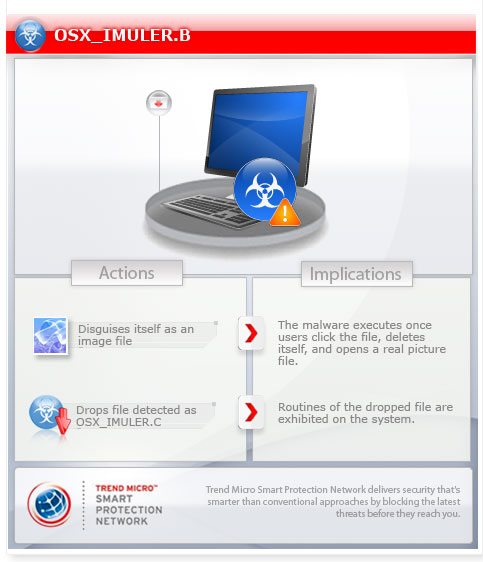OSX_IMULER.B
Backdoor:MacOS_X/Imuler.C (Microsoft), OSX.Imauler (Symantec), Trojan-Dropper.OSX.Revir.b (Kaspersky)
Mac OS X


Threat Type: Trojan
Destructiveness: No
Encrypted: No
In the wild: Yes
OVERVIEW
This malicious file disguises itself as an image file in order for users to install and execute its backdoor component.
To get a one-glance comprehensive view of the behavior of this Trojan, refer to the Threat Diagram shown below.

This Trojan is disguised as an image file. It arrives as a .ZIP file together with other image files.
Clicking this file executes the malware. It then deletes itself, then drops and opens a real picture file. This is done to trick unsuspecting users into thinking that it is a legitimate file.
This Trojan arrives on a system as a file dropped by other malware or as a file downloaded unknowingly by users when visiting malicious sites.
TECHNICAL DETAILS
Arrival Details
This Trojan arrives on a system as a file dropped by other malware or as a file downloaded unknowingly by users when visiting malicious sites.
NOTES:
This Trojan is disguised as an image file. It arrives as a .ZIP file together with other image files.
Clicking this file executes the malware. It then deletes itself, then drops and opens a real picture file. This is done to trick unsuspecting users into thinking that it is a legitimate file.
It decrypts its component file {malware path}/.conft to /tmp/.mdworker using the key file {malware path}/.confr. It then executes the dropped file /tmp/.mdworker, which is detected by Trend Micro as OSX_IMULER.C. The key file, {malware path}/.confr, is a .JPG file.
It copies the key file, {malware path}/.confr to {malware path}/TMP0M34JDF8 and /tmp/TMP0M34JDF8.
It drops and executes the file /tmp/launch-IORF98 which opens the image file {malware path}/TMP0M34JDF8, effectively hiding its malicious routines.
It deletes itself after execution.
SOLUTION
Step 2
Scan your computer with your Trend Micro product to delete files detected as OSX_IMULER.B. If the detected files have already been cleaned, deleted, or quarantined by your Trend Micro product, no further step is required. You may opt to simply delete the quarantined files. Please check this Knowledge Base page for more information.
NOTES:
To delete the component files:
- Open a Terminal window. To open a terminal window, double-click "Applications>Utilities>Terminal" in Finder.
- In the Terminal window, type the following commands:
- Close Terminal by pressing ⌘ (Command) + Q.
rm /tmp/launch-IORF98
rm {malware path}/TMP0M34JDF8
rm /tmp/TMP0M34JDF8
rm {malware path}/.conft
rm {malware path}/.confr
Did this description help? Tell us how we did.


